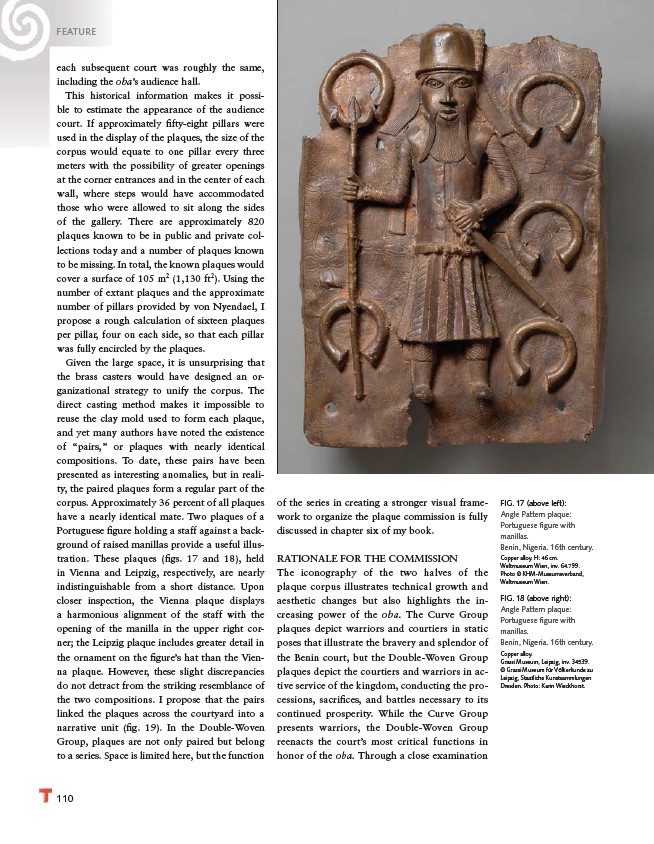
FEATURE
each subsequent court was roughly the same,
including the oba’s audience hall.
This historical information makes it possible
110
to estimate the appearance of the audience
court. If approximately fi fty-eight pillars were
used in the display of the plaques, the size of the
corpus would equate to one pillar every three
meters with the possibility of greater openings
at the corner entrances and in the center of each
wall, where steps would have accommodated
those who were allowed to sit along the sides
of the gallery. There are approximately 820
plaques known to be in public and private collections
today and a number of plaques known
to be missing. In total, the known plaques would
cover a surface of 105 m2 (1,130 ft2). Using the
number of extant plaques and the approximate
number of pillars provided by von Nyendael, I
propose a rough calculation of sixteen plaques
per pillar, four on each side, so that each pillar
was fully encircled by the plaques.
Given the large space, it is unsurprising that
the brass casters would have designed an organizational
strategy to unify the corpus. The
direct casting method makes it impossible to
reuse the clay mold used to form each plaque,
and yet many authors have noted the existence
of “pairs,” or plaques with nearly identical
compositions. To date, these pairs have been
presented as interesting anomalies, but in reality,
the paired plaques form a regular part of the
corpus. Approximately 36 percent of all plaques
have a nearly identical mate. Two plaques of a
Portuguese fi gure holding a staff against a background
of raised manillas provide a useful illustration.
These plaques (fi gs. 17 and 18), held
in Vienna and Leipzig, respectively, are nearly
indistinguishable from a short distance. Upon
closer inspection, the Vienna plaque displays
a harmonious alignment of the staff with the
opening of the manilla in the upper right corner;
the Leipzig plaque includes greater detail in
the ornament on the fi gure’s hat than the Vienna
plaque. However, these slight discrepancies
do not detract from the striking resemblance of
the two compositions. I propose that the pairs
linked the plaques across the courtyard into a
narrative unit (fi g. 19). In the Double-Woven
Group, plaques are not only paired but belong
to a series. Space is limited here, but the function
of the series in creating a stronger visual framework
to organize the plaque commission is fully
discussed in chapter six of my book.
RATIONALE FOR THE COMMISSION
The iconography of the two halves of the
plaque corpus illustrates technical growth and
aesthetic changes but also highlights the increasing
power of the oba. The Curve Group
plaques depict warriors and courtiers in static
poses that illustrate the bravery and splendor of
the Benin court, but the Double-Woven Group
plaques depict the courtiers and warriors in active
service of the kingdom, conducting the processions,
sacrifi ces, and battles necessary to its
continued prosperity. While the Curve Group
presents warriors, the Double-Woven Group
reenacts the court’s most critical functions in
honor of the oba. Through a close examination
FIG. 17 (above left):
Angle Pattern plaque:
Portuguese fi gure with
manillas.
Benin, Nigeria. 16th century.
Copper alloy. H: 46 cm.
Weltmuseum Wien, inv. 64.799.
Photo © KHM-Museumsverband,
Weltmuseum Wien.
FIG. 18 (above right):
Angle Pattern plaque:
Portuguese fi gure with
manillas.
Benin, Nigeria. 16th century.
Copper alloy.
Grassi Museum, Leipzig, inv. 34539.
© Grassi Museum für Völkerkunde zu
Leipzig, Staatliche Kunstsammlungen
Dresden. Photo: Karin Wieckhorst.